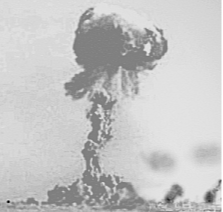Field Marshall Heinz Gustov slammed his fist into the flimsy table in his field HQ, sending map, markers, and a cup of water flying out in random directions. For a moment he was not the calm and calculating Field Marshall he had become, but rather the rough and raw panzer commander who'd survived the grinding combat of the Eurasian War. Rage filled him. He had been so close. His plan had worked, the British were routed! And now this. The British had cheated him with their atomic ace card. He looked up, eyes intent on the dark black smoke that marred the northern sky long after the mushroom cloud had been twisted beyond recognition by wind currents.
Fully 80% of his hard-won fuel was gone, never to fuel even a single one of his panzers. Nearly half of his trucks were gone as well, caught in the atomic blast as they'd been busy transporting fuel from the captured storage bunker to sites scattered around the area. He'd anticipated the possibility of the British destroying the fuel storage facilities, but had hoped he could get at the fuel and move it before then. The 20% he had saved would not support further offensive operations. The thought almost made him slam the table again, but with an effort of will he controlled himself, letting the rage drain into cool, focused, determination.
November 25th 1949
U.S. forces entering Lisbon are met by cheering crowds and welcoming Portuguese officials. The two U.S. landings have now fanned out, linked up, and secured Lisbon and other strategic points in western Portugal. More U.S. forces now begin to arrive at Portuguese ports despite intensifying German ballistic missile strikes.
German and Italian forces, such as they are, have taken up positions to block or at least slow down any U.S. effort to advance deeper into the Iberian peninsula. Their task seems futile in the face of growing Alliance superiority in the region.
November 28th 1949
The U.S. SBC(Strategic Bombing Command) undertakes operation ‘Tumble Down’, the largest single coordinated atomic attack of the war to date. In the span of five hours, seventeen atomic detonations will rock ‘Fortress Europa’ while seven atomic bombs will be lost in the skies over Europe, victims of downed B-34 bombers.
November 29th 1949
Though the German leadership is still reeling in the aftermath of the massive attack and trying to ascertain the full scope of events, the retaliatory action is nonetheless swift.
At POW camps all around NAZI Europe, Gestapo and SS units begin liquidating Alliance prisoners by the many thousands. Several camp uprisings are crushed brutally with more executions taking place. Reacting to the shrill objections of the Alliance and the Red Cross, Germany calls the executions “justice” for the “war crimes” against German cities. In all, 50,000 Alliance prisoners(most of them British but a number of Americans as well) are killed over the course of the next week.
In a more direct retaliation, fifty VX-armed ballistic missiles and another seventy five conventional and sarin-armed ballistic missiles slam into London, concentrated generally on industrial and residential sectors.
Despite the widespread availability of chemical protection gear, London experiences nearly eighty thousand casualties immediately or in the aftermath of the attack and moderate damage across several parts of the city. Portions of the city will remain uninhabitable for days to come. One small cluster of missiles, whether by intention or pure random chance, strikes close to the parliament building - further damaging the famous structure and killing several members of Parliament.
Although the attack is modest compared to the massive assault on Axis Europe, it is still a heavy blow for a war weary, hungry, and besieged British population.
Despite the atomic devastation in western Europe; in the East the German advance continues. As German panzers stream into southern Russia, Luftwaffe bombers hammer Russian rail lines south of Moscow. The last Soviet reserve army is attempting to deploy south to reinforce the thin Soviet lines on the Volga. Desperate for their reinforcements to make it through, the Soviets throw their last carefully husbanded Red Airforce strength and fuel reserves into securing these vital lines of communication.
November 30th 1949
Soviet political police battalions have begun executing German and Ukrainian prisoners en masse as the Mutiny gains strength in southern Russia, choosing a massacre over letting the hostile prisoners fall into the hands of the rebels.
In Libya, British forces moving west from Tobruk link up with their forces east of Benghazi, relieving the Benghazi pocket. Following the atomic bombing of the fuel depot at Al Bayda, Axis forces have retreated to the positions they held prior to the launch of their ambitious offensive. With much of its armor strength destroyed in the past few weeks, and now critically low on fuel, Army Group Africa has no choice but to go on the defensive.
December 1st 1949
With pitched battalion and division scale battles raging between loyalist and mutineer forces for most of a week in southern Russia, the Red Army mutineers have begun to gain the upper hand and secure the area west of the Volga. Loyal Red Army and political units are streaming in a disorganized mass east across thin Soviet lines at the Volga. Over 200,000 German and Ukrainian prisoners of war are slaughtered with machine guns or chemical weapons before the mass executions are halted by the mutineers.
In the skies between Moscow and Beriagrad, a surge of Soviet fighters has temporarily renewed the air war over the Eastern Front. The Red Airforce pilots, mostly experienced veterans flying a mixture of aging British designed Meteor Jet fighters and late-model Soviet prop fighters, fight valiantly in the face of overwhelming odds - often resorting to ramming and suicidal runs at bombers to disrupt the intense German bombing campaign. The Soviet efforts are marginally successful, giving Soviet rail lines a brief respite at the cost of the last strength of the Red Airforce being spent.
The last defenders of Kiev finally surrender, their morale shattered by the mutiny to their east and relentless Axis chemical and conventional shelling.
In the north, German mechanized forces have broken through four of the five defensive belts south and southeast of Leningrad, advancing some 45 kilometers at the cost of two hundred thousand casualties and two hundred panzers destroyed. Sensing an end to the meat-ginder in sight, German commanders press home their attack, committing their armored reserve to the point of greatest penetration. The 5th SS panzer division surges forward.







